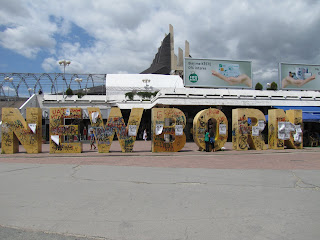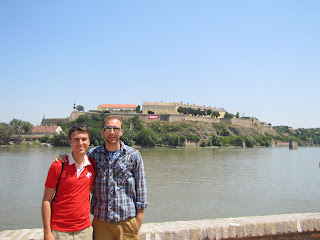The last few days have been extremely hectic. The experiences of the last days seem like a dream or a surreal experience. We have been in three or four countries (depends who you ask) in the few days. Although there are many tales to tell, please allow me to attempt to relate to you the story of the last couple of days in two posts.
After visiting the quaint city of Niš, we headed south towards Pristina, Kosovo. First we stopped in a World War II Concentration Camp called
Crveni Krst. It was an extremely powerful experience. Seeing the barb wire fences, the guard towers, the prison cells, the clothes the prisoners wore, etc. is incredibly shocking.
This particular concentration camp was a "collection camp" used to house prisoners (Jews, Roma, Communists, Partisans, Serbs) and then send them to other labor or death camps in either the Balkans or throughout the rest of Europe. Around 30,000 people were held in this camp from 1941 until 1944, when the camp was liberated by the Yugoslav Partisans. I had never been in a concentration camp, so the visit made quite an impression on me.


After this morbid, yet fascinating visit, we hit the road towards Kosovo. After a few hours, we finally hit the border between Serbia and Kosovo. I was incredibly excited to see Kosovo. I expected to see a war-torn area where houses and vehicles were on fire, tanks occupied the streets and poverty flooded the region. I obviously knew that this was unrealistic, but since all I have read about Kosovo was from the 1998-1999 War, I at least expected to see a region with extreme problems and a heavy troop presence. However, I was very wrong regarding my expectations.
When we first entered Kosovo, the first thing I could notice was the incredible amount of construction underway everywhere. A great amount of development was taking place before my eyes. Everywhere houses, businesses, and mosques were being built. Either the region has received a great amount of investment to expand, or people are rebuilding communities that were destroyed in the war 12 years ago. Finally we entered Pristina, the capital of Kosovo. Once again, there was a tremendous amount of construction everywhere. We passed by the statue of Bill Clinton, who is a hero in Kosovo along other policy makers like Madeline Albright (former Secretary of State) and Tony Blair. Also, I saw posters of KFOR, the NATO mission in Kosovo, and a few UN buses. That night, we settled in our hotel and a few of us took went to the main boulevard, Mother Teresa Street, to take a night stroll. Along with some friends, I saw monuments of Albanian national hero's (Kosovars are ethnic Albanians), many Albanian flags, and posters of Kosovars who had lost their lives in the 1998-1999 conflict with Yugoslav (Serb) forces.

The next day, we met with an NGO named Kosovan Nansen Dialogue, which is dedicated to facilitating dialogue between Kosovars and Serbians. For example, this NGO has one project which enables Serbs who lived in Kosovo before the war, to return, if they wish, to their homes in Kosovo.
After this meeting, I walked around Pristina for about an hour. I walked in the main boulevard, and throughout other streets in the center. I saw NATO KFOR troops, an EU building, and a UN compound. An there are many buildings that are being built with US and European investment. Obviously, there is a heavy international presence that sustains Kosovo stable economically.
I also saw the famous "Newborn" sign that was put in place following Kosovo's unilateral declaration of independence in 2008.
After seeing Pristina, we stopped shortly in a field where the 1389 Battle of Kosovo took place. This battle is incredibly significant in Balkans history. For Serbs, this battle serves as a rallying cry as to why Kosovo is the cradle of their "civilization". Basically, in 1389 the Ottoman Empire was moving north to conquer new lands. They faced the Serb army led by Prince Lazar in the field of Kosovo. The Ottomans defeated the significantly smaller Serb army, yet the Ottomans suffered a very high number of casualties. Although the Serbs lost, it serves as a symbol of Serb resistance and struggle. In this field there is now a tower that serves as a monument. Unfortunately it has to protected by NATO KFOR troops because Albanian groups have threatened to burn the monument in past years.

After this short stop we drove to Mitrovica, a city in northern Kosovo. Basically, it is a small city which is divided between Albanians and Serbs. In the south, Albanians are the dominant ethnic group, and in fact I believe no Serbs live in this sector of the city. The Serbs live in the north of the city. The two ethnic groups are divided by a single bridge, which in itself serves as a symbol of the deep ethnic divides throughout the region. In this small city there exists a heightened security presence, as I observed KFOR, EU, Italian Carabinieri and local police vehicles lined along the bridge. On the southern portion you only see Kosovar and Albanian flags. Upon crossing the bridge, Serbian flags flood the streets. We spoke to a local Serb politician who told us of the difficult economic conditions his community lived in. They had been blockaded necessities (such as water) by the southern part, and hence they received a large amount of aid from Serbia. It was extremely interesting to see a divided city that still, 12 years after the war, had tremendous problems of coexistence and where ethnic tensions were strong and prevalent.

We left Kosovo shortly after and headed back into Serbia, where we would spend one last night before heading to Bosnia-Herzegovina. The plan was to go to Novi Pazar in southern Serbia and then to Mokra Gora in Western Serbia, and stay in Mokra Gora for one night. However, the plan did not go very smoothly...
When we approached the Serbian security checkpoint (not border as Serbia does not consider Kosovo to be an independent state and thus there are no international borders), we encountered a bit of a problem. The previous day when we entered Kosovo, Kosovar customs authorities stamped our passports. This was against our wishes, as we had told the Kosovar authorities not to stamp our passport, knowing that if we were stamped we could potentially face problems re-entering Serbia. However, they decided to stamp their authority quite literally on our passport. This action, by the way, is illegal. The Serb authorities could not let us back into Serbia due to the stamp which they did not recognize, and due to the checkpoint not being a border control, they could not simply annul our stamp. Thus they suggested two courses of action:
1) Talk to EULEX (EU Rule of Law Mission in Kosovo) and have them call customs committee in Serbia that will allow us to enter Serbia despite the Kosovar stamp.
2) Enter Montenegro, which recognizes Kosovo, and from Montenegro enter Serbia. In Serbia they can then annul the Kosovo stamp due to entering from an international border crossing with customs authorities who can annul or de-legitimize the Kosovar stamps.
Our professors talked to a representative of KFOR, I believe, who informed them that the first option was virtually impossible. Thus, we began our trek to Montenegro. I do not remember how many hours our bus ride was, but it was an incredibly lengthy journey. At least the landscapes were absolutely breathtaking. We traveled on mountainous roads, which overlooked incredible views of small villages, beautiful lakes, and just overall natural beauty. At night there was a magnificent view of the stars too. Anyway, we finally reached Montenegro and had absolutely no problems crossing the border. We stayed at a beautiful hotel in a town close to the Serbian-Montenegrin border. It is by far the best hotel we have stayed at. The next day, as highlighted by the upcoming post, was utterly incredible. Please stay tuned to hear about the epic journey into Sarajevo.


































